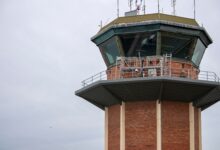The City of New York Settles With Injured Worker for $7.5 Million

Plaintiff Tomasz Zuraw, 41 years old on the date of the incident, Saturday 3/16/2019 around 3:00 a.m., was a carpenter employed by third-party defendant Whitestone Construction Corp. Defendants had contracted with Whitestone as General Contractor for a major façade renovation project of 65 Court Street, Brooklyn, involving replacement of all windows. The building was the administrative headquarters of defendants New York City Department of Education and New York City Board of Education and was owned by defendant City of New York.
The building had a single loading bay and dock on the Livingston St. side of the building. The replacement panels of glass were loaded on a flatbed by Whitestone at its yard, panels of glass, each 10 feet by 5 feet and weighing about 100 pounds each, were put standing on edge in each wooden partially framed crate. The glass panels inside each crate were not secured by any means. The work was done at night so as not to interfere with DoE/BoE normal administrative operations. Typically, the crates were offloaded from the flatbed while the truck was parked on Livingston St., with a forklift lifting one crate at a time, carrying it into the bay and placing the crate on the elevated loading dock. There, workers would remove one side of each crate and two men, each with a suction cup grip, would raise one panel at a time to clear the bottom of the crate and carry it inside to a freight elevator.
For reasons unknown, on the night in question the flatbed was backed into the bay until its rear edge was almost flush with the dock. The surfaces of the flatbed and the loading dock were approximately 5 feet above the concrete floor of the bay. There were no guard rails, toe boards or any other equipment placed to prevent anyone or anything from falling off the sides of the flatbed. Cross-bracing was attached from one side of each crate being unloaded to one wall of the bay to try to prevent it from tipping or falling as each individual panel was lifted and carried away, but otherwise unloading was done as described.
There were 5 crates on the flatbed that night. After two crates had been unloaded, plaintiff, who had been working inside, was told by his foreman to go and help with the unloading. He joined 2 other workers in the bay. He and one co-worker each used a suction cup grip to unload two panels, one at a time, and walk them inside, while a 3rd worker used his weight to hold the remaining panels in the partially stripped crate from tipping. While unloading each panel, Mr. Zuraw had to stand on the flatbed in the space between the crate and the flatbed’s unprotected driver’s side edge. As Mr. Zuraw and his co-worker were hoisting the third panel, the 20 or so remaining glass panels in the crate began to tip over toward plaintiff and fall, striking him and the panel he was hoisting. The force of the falling panels knocked him off the flatbed headfirst to the ground 5 feet below. The glass panel Mr. Zuraw was hoisting fell on top of him and broke, followed by multiple additional panels falling out of the crate, landing and breaking on top of him. The 3rd worker was unable to stop or prevent the remaining panels from falling and was himself also knocked off the flatbed to the floor. Workers struggled to free Mr. Zuraw and after about 90 seconds, he was able to wriggle free, crawl out from under the glass, under the flatbed and get out near its rear.
A surveillance video of the entire incident was obtained by plaintiffs in a pre-action disclosure proceeding despite defendants’ opposition.
Plaintiffs alleged that defendant City of New York as owner, and defendants New York City Board of Education, New York City Department of Education as lessees, had violated Labor Law §240(1) in failing to provide him with adequate safety devices to protect him against gravity related risks of falling off his elevated work platform or objects falling, as well as failing to provide proper equipment for safely hoisting and lifting materials being unloaded. Plaintiffs argued that a guard or rail should have been placed around the sides of the flatbed, that braces or stays should have been used to ensure that the remaining panels in the crate could not fall or tip and that proper equipment should have been provided for hoisting the panels.
Defendants argued that Labor Law §240(1) was inapplicable under the circumstances of this incident. They argued that the truck’s flatbed did not qualify as a work platform and that the 5-foot height differential between the flatbed and concrete floor was insufficient to qualify for §240(1) protection. They also argued that plaintiffs’ GML §50 Notice of Claim had not provided adequate notice of all claims ultimately pled in their Summons and Complaint and Bills of Particulars.
Plaintiffs moved for summary judgment, which was granted by Hon. Consuelo Mallafre Melendez, who found that plaintiffs had established prima facie that defendants violated §240(1) and that defendants had failed to raise any triable issues of fact. She rejected defendants’ reliance on older Second Department cases and specifically approved plaintiffs’ arguments citing Runner v. New York Stock Exchange, 13 N.Y.3d 599 (2009), that there was no specific height differential a person or object must fall to invoke §240(1) protection and that the differential here required such protection. She also accepted plaintiffs’ argument that Wilinski v. 334 E. 92nd Hous. Dev. Fund Corp., 18 N.Y.3d 1 (2011), rendered irrelevant that the falling objects – here, the glass panels – were on the same level as plaintiff. Last, she rejected defendants’ claim that plaintiffs had not adequately or timely pled their theories of recovery.
Tomasz Zuraw suffered lacerations to one ear and his head and was taken by ambulance to New York Presbyterian – Brooklyn. His lacerations were sutured and he was sent home with his wife. X-rays there revealed a fractured right ankle, but it was just wrapped and he was told to consult a his own physician. On Monday, 3/18/2019, because of his severe pain, his wife took him to the Emergency Room at New York-Presbyterian Hospital in Manhattan. There, a comprehensive workup revealed an oblique fracture of the lower third of the right fibula into the ankle and a tear of the deltoid ligament in the right ankle, as well as a fracture of the pisiform, a bone in his right wrist. Because of swelling, the ankle was not operated on until two weeks later, 4/2/2019, when Dr. Steven Behrens at New York-Presbyterian Hospital performed an open reduction and internal fixation with placement of a plate and multiple screws. The right wrist was splinted on 3/18/2019 and was operated on by Dr. Mark Pruzansky at Mount Sinai Hospital on 5/3/2019, who removed the damaged portion of the right pisiform and repaired multiple tendons. In 2022, Dr. Behrens operated and removed the hardware from the ankle because of pain and development of symptoms of Complex Regional Pain Syndrome.
Mr. Zuraw was also diagnosed with mild traumatic brain injury and post-concussion syndrome, for which he received treatment by cognitive therapy until 12/2022, and medication.
Plaintiff alleged that he was permanently completely disabled from work, and that as a union carpenter he had been earning approximately $80,000/year at the time he was injured. He claimed economic loss of $5,200,000 from loss of wages and benefits.
Defendants appointed two medical examiners, an orthopedic surgeon and a neurologist. The orthopedic surgeon claimed that plaintiff’s right ankle was completely recovered and there was no reason he could not return to work. The neurologist said there were no signs of CRPS and that plaintiff was fully capable of working in his former capacity.
Specials Claimed:
Workers’ Compensation Lien – $370,341.91, which would have required plaintiff to repay 2/3 or $246,895.84.
Settlement: $7,500,000, pre-trial, which included:
City of New York: $7,053,104.16
Whitestone Construction Corp: $200,000.00
Chubb waived repayment of $246,895.84, the portion of the Workers Compensation lien for which plaintiff was responsible.
Mr. Zuraw was represented by David B. Golomb of Golomb & Longo, PLLC.


